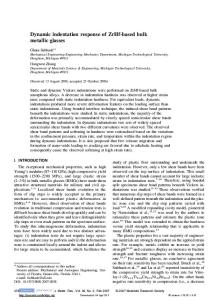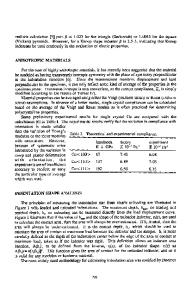Indentation Response of Nanostructured Turfs
- PDF / 629,522 Bytes
- 6 Pages / 612 x 792 pts (letter) Page_size
- 98 Downloads / 311 Views
1049-AA02-08
Indentation Response of Nanostructured Turfs A. A. Zbib1, S. Dj. Mesarovic1, D. F. Bahr1, E. T. Lilleodden2, J. Jiao3, and D. McClain3 1 Mechanical and Materials Engineering, Washington State University, PO Box 642920, Pullman, WA, 99164-2920 2 GKSS, Geesthacht, Germany 3 Physics, Portland State University, Portland, OR, 97207-0751 ABSTRACT When grown via chemical vapor deposition carbon nanotubes (CNTs) may take on the form of a “turf”, consisting of many CNTs with a complex interconnectedness attached to an inflexible substrate. These turfs can be formed over large areas and with a range of heights (between 1 to 100 µm), and grown on photolithographically patterned catalysts to form different aspect ratios. This study focuses on the indentation and permanent deformation of CNT assemblages under applied contact loading. Nanoindentation was conducted on CNT turfs and the properties, nominally the turf’s elastic modulus and hardness, were 14.9 MPa ± 5.7 MPa and 2 MPa respectively. The onset of permanent deformation during indentation occurred at applied stresses of 2.5 MPa. The turf’s collective permanent deformation under applied compressive loading was also studied. A model predicting the buckling stress of CNT turfs is also described. INTRODUCTION A substantial amount of work in literature has been done investigating the mechanical1, electrical2 and thermal3 properties of CNTs. However, most of this work has been focused on single tubes, whether single-walled carbon nanotubes or multi-walled carbon nanotubes. CNT turfs are complex structures of intertwined, nominally vertical tubes4. There are fewer reports that explore the properties of a bundle of CNTs in a turf like structure5,6 and deformation under applied compressive loading7,8. Work conducted on CNT turfs has shown that these structures behave differently than a single tube. Their complexity arises mainly from the tube-tube interactions and the presence of van der Waals bonding. For example the thermal conductivity has been shown to drop from several thousand to 200 W/mK due to tube-tube interactions and tube bending and physical contacts9. Qi et al. conducted indentation tests on isolated aligned MWCNT samples grown by plasma enhanced chemical vapor deposition, and determined an effective axial modulus of a tube to be 0.9-1.23 TPa and an effective bending modulus to be 0.91-1.24 TPa5. In turf form Cao et al. studied the cyclic compression behavior of CNTs that were released from a substrate; these turfs were made of vertically aligned CNTs10. Their results showed that these films had a much higher compressibility and much higher strength than usual foam material. They showed that the stress-strain curve of the CNT film showed similar trends as foam materials; three stages occurred, with the first being a linear stress-strain relation with a high modulus (50 MPa), followed by a plateau characterizing the formation of zig-zag reversible buckles (at 22 % strain) and a reduction in modulus to 12 MPa, followed by a densification stage. This curren
Data Loading...











